State within a state: the Nazis in neutral Ireland
Published in 20th-century / Contemporary History, Features, Issue 6 (Nov/Dec 2006), The Emergency, Volume 14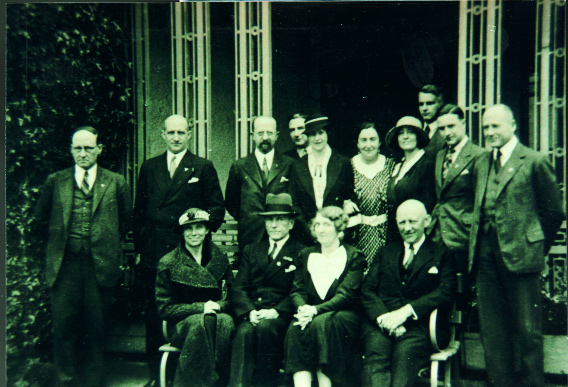
Sixtieth birthday party of Col. Fritz Brase (seated, wearing hat) at his Sandymount home, 4 May 1935. Other Nazi Party members include (standing, left to right) Adolf Mahr, Otto Bene (head of the Nazi Party in London) and Oswald Mueller-Dubrow (a director of Siemans engineering company).
They operated like a normal political party, collected subscriptions, kept membership files and reported regularly to party headquarters. The difference with the German Nazi Party (NSDAP) in 1930s Ireland, however, was that its headquarters was not in Dublin but in Berlin. The party’s membership—numbering from 50 to 100, depending on whether visitors are included—owed their loyalty to Adolf Hitler. Their Christmas parties were held at the Gresham Hotel, while other social events took place at the Red Bank restaurant in D’Olier Street and at the Kilmacurragh Park Hotel in County Wicklow.
Fritz Brase, first Ortsgruppenleiter
But who were these Germans and Austrians who rallied to the Nazi Party colours in pre-war Ireland? The first Ortsgruppenleiter, or local branch leader, in Dublin was a Prussian bandsman called Fritz Brase, who in 1923 became director of the new Irish army’s school of music, with the rank of colonel. Brase—who rearranged many traditional Irish jigs and reels to sound like thundering Prussian martial pieces—got into hot water in the early 1930s when he wrote to the army’s chief of staff, Maj.-Gen. Michael Brennan, seeking permission to set up a branch of the Nazi Party in Dublin. Brase was either unaware of or chose to ignore the obvious conflict of interest that his request implied—an Irish army colonel swearing loyalty to the Third Reich—but Brennan got the point. He told the German to choose the party or the army, but Brase wanted the best of both worlds. Records held in Berlin show that he joined the Nazis in April 1932, just a month before his 57th birthday. Brase appears to have tried to keep his party membership a secret from the Irish army, but pressure from the military’s top brass is the most likely reason why he relinquished his post as local Nazi leader in 1934.
Adolf Mahr
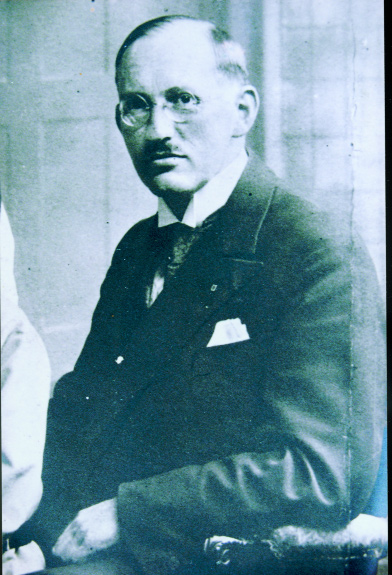
Dr Adolf Mahr on his appointment as director of the National Museum, Dublin, 1934. (National Museum of Ireland)
Brase’s successor was another Irish state employee, Dr Adolf Mahr, an Austrian archaeologist who had arrived in Dublin in 1927 to join the staff of the National Museum in Kildare Street (he was promoted to the top post of museum director in 1934 by Éamon de Valera’s cabinet). Mahr scoured the country buying artefacts for the museum but, like other party members, he had a hidden agenda. After taking over as party leader in Ireland, Mahr set about building up the NSDAP’s membership and was quite successful; at least 23 Germans were recruited to the party during Mahr’s 1934–9 term (roughly a quarter of all adult German males in the 26 counties). Mahr’s efforts on behalf of the Nazi Party were not restricted to German citizens. According to Irish military intelligence files, he ‘made many efforts to convert Irish graduates and other persons with whom he had associations, to Nazi doctrines and beliefs’.
Adolf Mahr was no ‘Mr Nice Guy’, and his recruitment methods have been described by Lt. Col. John P. Duggan (retd), a leading expert on Irish–German relations in the 1933–45 period, as ‘bully boy tactics’. Those targeted by Mahr appear to have been given the choice of joining the party or being packed off to the Fatherland in disgrace. Visiting Germans had to report first to Mahr or face a reprimand. Using his virtually unlimited powers within the small German colony, Mahr was able to get two diplomats (Georg von Dehn-Schmidt, in 1934, and Erich Schroetter, in 1937) sent home to Berlin for not toeing the party line. Perhaps understandably, from then on the German legation was staffed by loyal party members. They included Schroetter’s successor Dr Eduard Hempel, Hans Boden and Henning Thomsen, an SS officer who was transferred to Dublin from Oslo early in 1939. Mahr’s bullying tactics may also explain why a 61-year-old Malahide-based Lutheran minister, Wilhelm Tanne, felt obliged to join the party (in October 1934), even though the German Protestant churches (and the Catholic Church), for the most part, opposed Hitler.
From 1934 to 1939 Mahr was, de facto, Germany’s top diplomatic representative in pre-war Ireland. Dr Mahr even represented the Irish branch of the Nazi Party at the May 1937 coronation of George VI in London, where he was joined by Ribbentrop, then Hitler’s ambassador to the Court of St James. It was no coincidence, therefore, that Mahr secured a post as head of the Irish desk at the wartime foreign office in Berlin when Ribbentrop was foreign minister. Mahr also directed radio propaganda broadcasts to Ireland from 1941 to 1945. In the later stages of the war, his radio responsibilities were extended to include large parts of the English-speaking world. A major biography of Adolf Mahr by journalist Gerry Mullins (due to be published in 2007) will cast the Austrian in a more sinister light than hitherto seen, linking him to the Nazis’ core anti-Semitic plans, particularly in the propaganda sphere.
In pre-war Dublin, the German legation at 58 Northumberland Road (which nowadays houses the Instituto Cervantes or Spanish Cultural Institute) supplied Mahr with regular reports on the comings and goings of German nationals, including Jews, whose Irish addresses and movements were recorded in ominous detail. The legation’s radio transmitter was used to send secret political, economic and military information to Berlin (Éamon de Valera eventually ordered the seizure of the transmitter in December 1943, following pressure from the US ambassador, David Gray, uncle of Mrs Eleanor Roosevelt).
In his other role as director of the National Museum Mahr was friendly with de Valera, who in 1934 had obtained cabinet approval for the Austrian’s nomination to the top museum post. One of the museum director’s colleagues, a Scottish archaeologist, Dr Howard Kilbride-Jones, recalled that in June 1938, when Mahr needed additional funding to complete an archaeo-logical dig in Drimnagh, they called to the taoiseach’s office and left with de Valera’s personal cheque for £400 (about ?25,000 in today’s values).
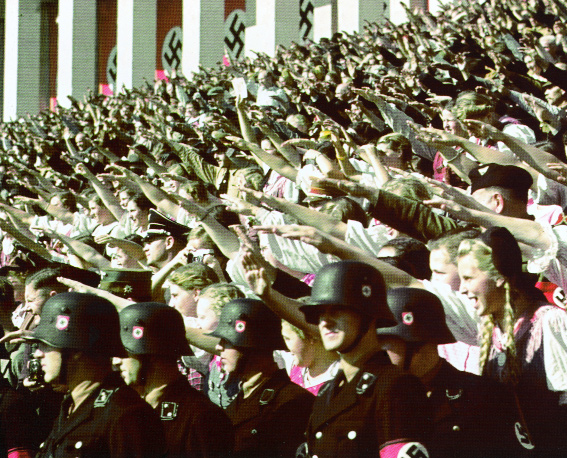
Annual Nazi Party rally in Nuremburg, 6 September 1938-Mahr left Dublin in July 1939 with the intention of attending the 1939 one, cancelled owing to the outbreak of war. (TimePix/Hugo Jaeger)
Nazi Party members like Adolf Mahr found themselves in an awkward position as state employees in the 1930s because, essentially, they could not serve two masters without a conflict of interest arising. Nor were they the only NSDAP members who tried simultaneously to serve the Irish state and Nazi Germany. Others included (date of joining Nazi Party):
Friedrich Herkner (1939), who was appointed professor of sculpture at the National College of Art in Dublin in 1938. He spent the war years in Germany and did restoration work on bomb-damaged public monuments there and in Austria after the war. Herkner was allowed back to teach again in the College of Art from 1947 until his retirement in 1969.
Otto Reinhard (1939), who was appointed director of forestry in the Department of Lands, having beaten 65 other candidates to get the job. He left his home in Silchester Road, Glenageary, for Germany at the outbreak of war and never returned to Ireland.
Friedrich Weckler (1934), who was appointed chief accountant of the ESB in 1930, having worked previously on the Shannon hydro-electric scheme for the giant German engineering company Siemens. Weckler died at his home in Dalkey in 1943, aged 51.
Heinz Mecking (1931), who worked as an expert adviser to the Turf Development Board (the forerunner of Bord na Móna) from 1936 to 1939. He took over as NSDAP chief in Dublin when Mahr left for Berlin in July 1939. When war broke out, Mecking joined the German army and later oversaw turf production for the Russian winter campaigns of 1941 and 1942. He died of starvation and hypothermia while a prisoner of the Red Army in December 1945.
Colonel Fritz Brase (1932), who came to Dublin in 1923 to be the first director of the Irish army’s school of music. He became the first group leader of the local Nazi Party branch in Dublin in 1933. Brase died at his Sandymount home in December 1940, aged 65.
Adolf Mahr was assisted in his Nazi Party duties by a Dublin-based Siemens director, Oswald Mueller-Dubrow, who operated as Mahr’s deputy in the Nazi Party’s ausland (foreign) organisation, which kept an eye on Germans living abroad, enforced discipline among party members and produced regular reports for Berlin.
Other party members living in pre-war Ireland included (date of joining Nazi Party):
Helmut Clissmann (1934), who studied at TCD before running the German Academic Exchange Service (DAAD) in Dublin. In his latter role, Clissmann supervised the placement of German students in Irish universities. Such students were obliged to join the Nazi Party in order to get funding for their trips to Ireland. The visits were funded by the DAAD, which was an organ of the NSDAP from 1933 to 1945. The DAAD also helped Irish students and teachers to study or work in Nazi Germany.
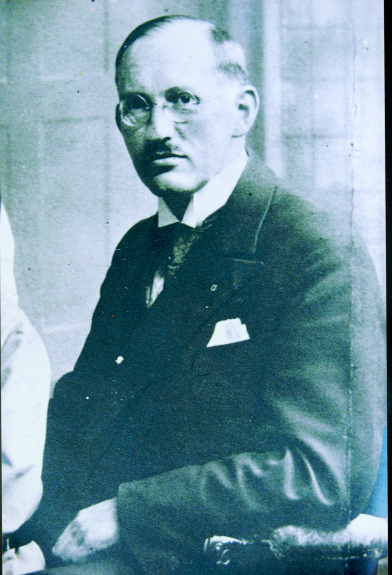
Professor Ludwig Muhlhausen studied Irish in Donegal in 1937, while taking hundreds of photographs for German military intelligence.
Heinrich Greiner (1936), who had come here in 1935 to help start up the Solus lightbulb factory in Bray, Co. Wicklow.
Hans Hartmann (1933), who from 1937 to 1939 was based at UCD, where he studied Irish language and folklore. During the war, Hartmann broadcast Nazi propaganda in Irish from Berlin.
Hilde Poepping (1937), an exchange student at University College Galway. During the war she worked with Mahr at the German foreign office and later at the Irish section of German Radio in Berlin, occasionally reading news bulletins for listeners in Ireland.
Karl Kuenstler (1933), an engineer with Siemens.
Dr Robert Stumpf (1934), a radiologist at Baggot Street Hospital. In 1939 Stumpf and his wife (who was also a medical practitioner) invited some Irish doctors and their wives on a tour of the Third Reich.
According to Irish military intelligence records, Adolf Mahr and Otto Reinhard were both employed during the war in ‘one of the German intelligence sections which dealt with matters concerning a landing in Ireland’. The German army had drawn up detailed documents for an invasion of Ireland to coincide with the invasion of England in 1940, and in August that year IRA men Seán Russell and Frank Ryan were to be landed on the Dingle Peninsula by U-boat (the plan was aborted when Russell died on board). In July 1939 Mahr had received a letter from an SS war maps office in Prague thanking him for his ‘efforts’.
But, in the 1930s, were de Valera and his ministers aware that Nazi Party members were on the state payroll? The answer would appear to be that a few top civil servants knew but that the taoiseach only became aware of what was happening early in 1939. For example, Todd Andrews, who was managing director of the Turf Development Board in the 1930s, recalled in his 1982 memoirs that:
‘As German triumph followed German triumph in Europe, he [Heinz Mecking] became increasingly uninvolved in his assignment [for the TDB]. He set himself up as a Nazi intelligence agent photographing railway stations, river bridges, sign posts and reservoirs . . . When war broke out he had to return to Germany, with reluctance. He thought that he would be more useful to his country acting as an intelligence agent in Ireland.’
The Germans living here were not, in fact, ordered back to Berlin after the outbreak of war on 3 September 1939; they held no less than three tense meetings at the Dublin legation in an effort to reach a consensus on what to do. Finally, the reports of Germans being interned as enemy aliens in Britain tipped the balance. They feared that they would spend the war as internees if British troops invaded Ireland, so they sought de Valera’s help to get back to the Fatherland. In one of Dev’s cannier wartime moves, he persuaded the British to grant 50 Germans safe passage through what was—technically, for them—enemy territory. They gathered at the mail boat at Dún Laoghaire on 11 September 1939 amid shouts of ‘Auf Wiedersehen’. Professor Herkner told an Irish Times reporter that they were ‘returning to Germany to join the colours’, and Heinz Mecking from the Turf Development Board gave a Nazi salute on the quayside before sailing with the others to Holyhead. (The departure of so many Germans with a detailed knowledge of Ireland meant that German counter-intelligence had to drop no less than twelve agents into Ireland, by submarine and parachute, between 1939 and 1943.)
Adolf Mahr had left Dublin two months earlier, officially for his annual holidays in Austria in July and to attend the sixth international congress of archaeology in Berlin in August. Unofficially, however, he had planned to attend the Nazi Party’s annual rally at Nuremburg in September (cancelled on the outbreak of war). In addition, since early 1939 he had been feeling the pressure from top Irish officials over his Nazi Party role, and had been shadowed both by the Garda special branch and the army’s military intelligence arm, G2.
In February 1939, the secretary of the Department of External Affairs, Joseph Walshe, reported to de Valera on his meeting with the newly arrived German diplomat Henning Thomsen:
‘I suggested to him, as I have frequently done to his minister [Hempel] and his minister’s predecessor [Schroetter] that the existence of a Nazi organisation in Dublin . . . having as its chief member and organiser an employee of our state [Mahr] was not calculated to improve relations between our two governments.’
The formal memo reveals that Walshe had been aware of what he called ‘the Nazi cell in Dublin’ since 1936, yet nothing had been done about it, apart from monitoring party members’ movements and intercepting their mail.
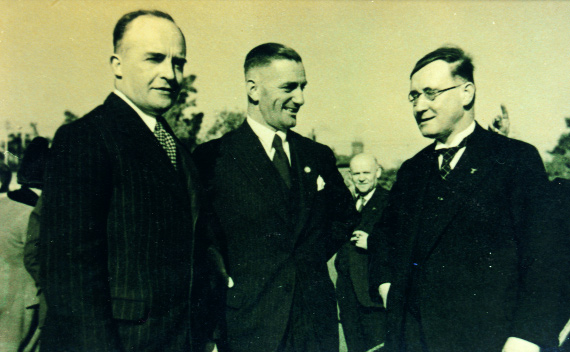
Dr Eduard Hempel, Dr Vogelsang and Dr Adolf Mahr at the German legation’s garden party in Dublin, 1938.
In fact, when it came to dealing with Nazi Party members in Ireland, the Dublin government’s hands were tied because, according to the rules, civil servants like Mahr were barred only from membership of Irish political parties, not foreign ones. In addition, spies such as Jupp Hoven (who studied at Trinity College and, during the war, together with Helmut Clissmann and IRA man Frank Ryan, tried to set up an Irish brigade of the German army) and Professor Ludwig Muhlhausen (who had taken hundreds of photographs of Sligo and Donegal in 1937, some of which later ended up in a German army invasion handbook) could not be touched because they had not broken any law. In 1937 a senior civil servant, León Ó Broin, reported Muhlhausen’s spying activities to a senior army officer, only to be told that it was not illegal to take holiday snapshots.
Very few members of the German colony returned to live in Ireland after the war. Helmut Clissmann was flown back in 1948 (having spent three years in a British internment camp, during which time he was ill treated) with the help of the then Irish minister for external affairs, Seán MacBride. In 1947 Professor Friedrich Herkner got his old teaching job back at the College of Art in Dublin, the only pre-war Nazi on the Irish state payroll to do so.
Otto Reinhard also tried to get his old job back at the Department of Lands, but his pleas fell on deaf ears. His case for reinstatement was not helped by a series of letters he sent to former colleagues in Dublin. In one he boasted of his forestry work in the Carpathian Mountains in occupied Romania. According to Reinhard, the locals appreciated having a professional forester like himself, rather than ‘some Jewish timber merchant’. In 1945 his former employers blocked his return to Dublin but agreed to his request for a written reference.
On his release from a British army internment camp in Germany in April 1946, Adolf Mahr sought reinstatement as director of the National Museum (technically he was on leave of absence from his job in Dublin). But, under pressure from MI5 and opposition TD James Dillon, de Valera heeded the advice of his military intelligence chief, Colonel Dan Bryan, that allowing the return of such a ‘blatant Nazi’ would be ‘unwise’. Mahr was pensioned off against his wishes and never set foot on Irish soil again.
David O’Donoghue is the author of Hitler’s Irish voices: the story of German radio’s wartime Irish service (Belfast, 1998), and The Irish Army in the Congo 1960–1964: the far battalions (Dublin, 2005).
Further reading:
S. Cronin, Frank Ryan: the search for the Republic (Dublin, 1980).
J.P. Duggan, Neutral Ireland and the Third Reich (Dublin, 1989).
R. Fisk, In time of war (Dublin, 1983).
L. Ó Broin, Just like yesterday (Dublin, 1985).
















